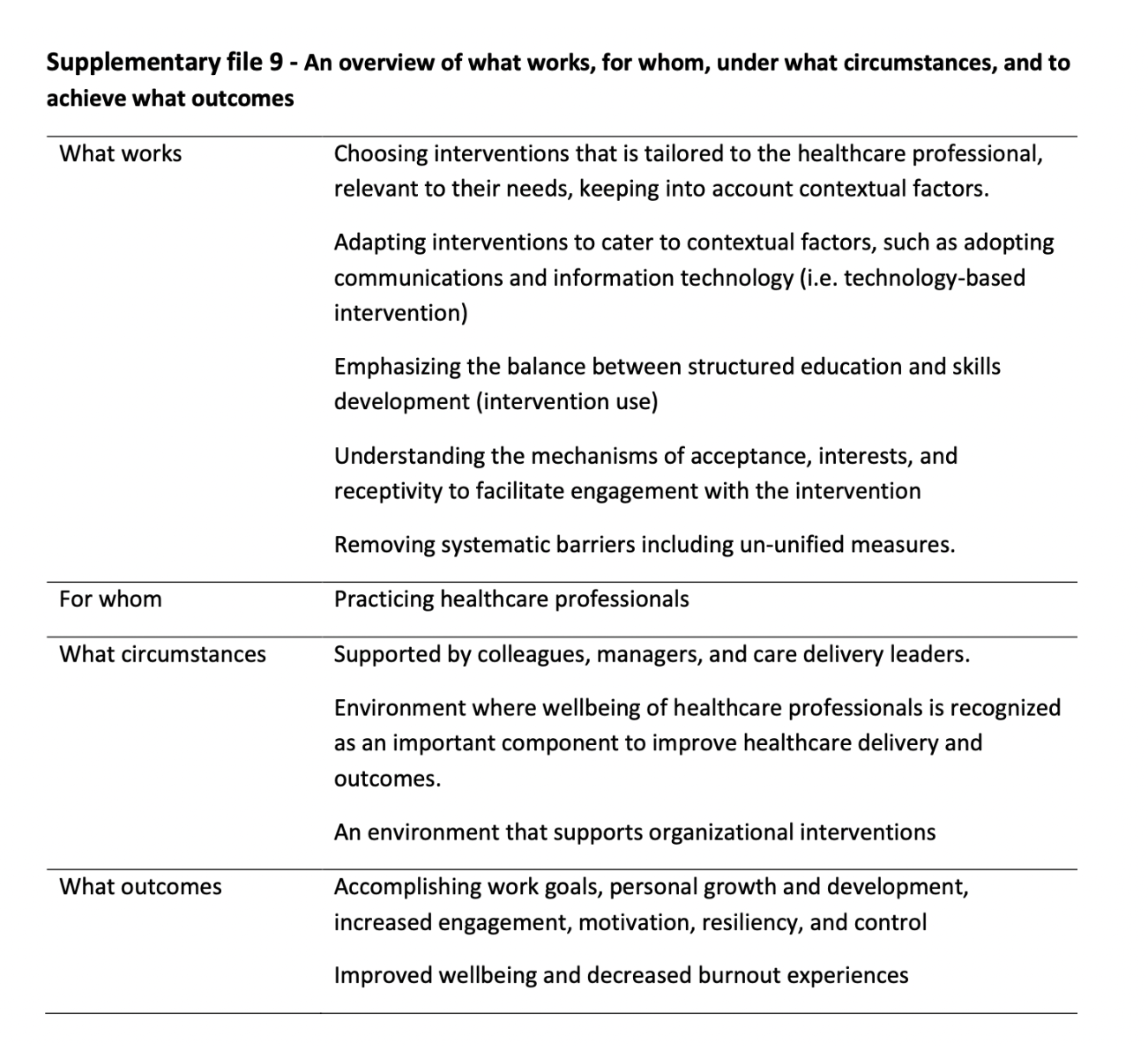Resources Blog
Burnout prevention, what works?
As the prevalence of burnout continues to impact individuals across diverse sectors, academic researchers have sought to elucidate effective strategies for prevention.
This brief overview provides a succinct exploration of noteworthy academic articles published in the field, distilling key insights and evidence-based approaches that contribute to the ongoing discourse on burnout prevention, and practical interventions that workplaces can consider that have emerging evidence for solutions that deliver results.
Article one:
Interventions to reduce burnout among clinical nurses: systematic review and meta-analysis
Miran Lee and Chiyoung Cha from Ewha Womans University in South Korea, conducted a systemic review and meta-analysis and was published in the prestigious journal of Nature in July 2023.
https://www.nature.com/articles/s41598-023-38169-8
The systematic review revealed that a mindfulness-based program was the most frequently used intervention for nurse burnout. Meta-analysis studies19 showed that mindfulness-based programs are effective in reducing nurse burnout.
However, burnout refers to a state of physical, mental, and social exhaustion that may require various interventions. A systematic review of health professional burnout programs revealed that a vast array of interventions have been adopted alone or in combination24. Although mindfulness-based programs are helpful in lowering burnout level, their role might be limited to managing burnout rather than preventing or managing situations for burnout60.
In many cases, the causes of burnout are multifaceted, which include but are not limited to issues with limited manpower, working longer shifts, not having schedule flexibility, and responding to high work and psychological demands11. Systematic support to improve work environments and tailored programs to train nurses to prevent repeated situations are needed.
_____________________________________________________________________________________
Article TWO:
What are the solutions for well-being and burnout for healthcare professionals? An umbrella realist review of learnings of individual-focused interventions for critical care
This study was conducted by Australia (South Australia and NSW) and New Zealand (Hawkes Bay Hospital) based researchers and was a ‘Realist review’ of the recent literature for burnout prevention solutions.
A total of 81 interventions from 17 reviews were mapped, including mindfulness interventions, cognitive–behavioural therapy, self-care and coping strategies. They noted that the revised programme theory determined that contextual factors such as ethnicity, workload, and work schedules play a crucial role in determining the effectiveness of interventions. Mechanisms including the interventions’ interests, acceptance, and receptivity are also influential in determining engagement and adherence to the intervention.
Findings from this study suggest that the solution for burn-out is complex. However, it offers an optimistic view of tailoring and customising one or a combination of interventions, integrating structured education and components of emotional intelligence. Of those 81 interventions, the top evidence were for Self-care, social support, awareness or mindfulness and self-efficacy are prime components to improve emotional intelligence and resilience for critical care healthcare professionals to improve well-being and decrease burn-out experience.
Furthermore, the authors also describe a framework for how to apply the evidence in a ‘realist’ way, and have called the model PERMA Theory - Positive Emotion, Engagement, Relationships, Meaning, Accomplishment, with six key questions to consider when tailoring a programme or resource.

Table of interventions with some statistical significant evidence for burnout prevention:
- Mindfulness and cognitive training (n=37) (mindfulness (n=22), acceptance and commitment therapy (n=1) cognitive–behavioural therapy (n=1), emotional intelligence (n=5), resilience (n=1), self-management and recovery training (n=1), Balint group (n=1), neuro-linguistic programming (n=1), resilience (n=1), Relaxation Response Resiliency Programme for Palliative Care Clinicians (n=1), Background Affect Trouble Handling and Empathy (n=1), Activities Contributing Comparisons Emotions Pushing Away Thoughts Sensations (n=1)).
- Self-care intervention (n=16) (self-compassion (n=2), massage (n=2), aromatherapy (n=4), breathing (n=1), relaxation (n=1), narrative (n=2), knitting (n=1), music (n=2), art (n=1).
- Self-improvement (n=9) (education/workshop (n=4), self-reflection (n=1), career training (n=1), mental practice session (n=1), micro-task (n=1), adaptation practice (n=1)).
- Low-intensity exercise (n=5) (yoga (n=2), Qigong (n=1), Tai chi (n=1), Physical exercise ((non-) workplace-based, individually designed (n=1)).
- Social support (n=5) (counselling (n=1), support group (n=2), debriefing (n=2)).
- Mixed interventions (n=5) (education on CBT (n=1), job awareness with assertive training and time management (n=1), massage and aromatherapy (n=1), biofeedback relaxation and workshop (n=1), mindfulness and communication and self-awareness workshop (n=1).
- Miscellaneous uncategorised interventions (n=4) (heart touch (n=1), auriculotherapy (n=1), Didactic or interactive instruction in biopsychosocial approach (n=1), respiratory one (n=1)).


______________________________________________________________________________
Article THREE:
A moderated mediation study of high-performance work systems and insomnia on New Zealand employees: job burnout mediating and work-life balance moderating
Professor Jarrod Haar and Candice Harris from Massey University.
https://www.tandfonline.com/doi/abs/10.1080/09585192.2021.1961161
OTHER ARTICLES OF INTEREST:
https://www.nature.com/articles/s41598-023-38169-8
https://www.ncbi.nlm.nih.gov/pmc/articles/PMC9462087/
Nurse burnout before and during the COVID-19 pandemic: a systematic comparative review
https://onlinelibrary.wiley.com/doi/pdfdirect/10.1111/ijsa.12393
Written by chnnl Team

.svg)


.svg)